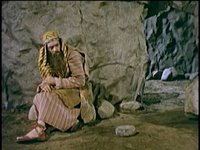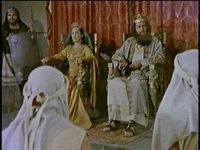 Having reviewed the Testament - Bible in Animation version of Elijah a couple of weeks ago, I wanted to have a look at 1958's Elijah, A Fearless Prophet.
Having reviewed the Testament - Bible in Animation version of Elijah a couple of weeks ago, I wanted to have a look at 1958's Elijah, A Fearless Prophet.Introduction to Elijah & Ahab - (1 Kings 16:29-34)
Elijah predicts drought - (1 Kings 17:1)
Elijah and the Ravens - (1 Kings 17:2-6)
Elijah and Widow of Zarephath - (1 Kings 17:7-24)
Elijah and Prophets of Baal - (1 Kings 18:1-2, 16-40)
End of the Drought - (1 Kings 18:45-46)
Elijah on the mountain - (1 Kings 19:1-18)
Elijah calls Elishah - (1 Kings 19:19-21)
Elijah taken to Heaven - (2 Kings 2:1-14)
 Notes
NotesThe first thing to note is how similar the scene selection is to the Testament version. This is largely because the biblical material on Elijah is fairly small. But it is also noticeable that both exclude the incident with Obadiah, both exclude the incident where Elijah sends his servant to search for the clouds, both omit Elijah's marathon run ahead of Ahab's chariot, and both omit Fire from heaven burning two of Ahaziah's captains. Yet neither show Jezebel or Ahab's deaths (1 Kings 21-22, 2 Kings 9)
These exclusions are fairly significant in two ways. Firstly, they give Elijah the human qualities that are so central to his character. Elijah's hopes for the ending of the drought as he yearns for even the smallest indicator of its end. Elijah's breakdown and his complaints in 1 Kings 19:4&10 that he is the only prophet of God left, should be seen in this context. Firstly, Obadiah has already told Elijah that he has saved many prophets. Secondly, Elijah hits this low, not only after a major spiritual confrontation, but also following a run from Carmel to Jezreel (which, I believe, is about 20 miles), following a sever drought. It's no surprise given the exhaustion Elijah must be feeling that he hits such a low, and is unable to see things clearly. By excluding these two incidents both films paint his breakdown in a fairly positive light, and indeed, in both scenes Elijah seems neither that shattered or particularly suicidal.
Secondly, it exorcises the more troubling aspects of the story. The slaying of the prophets of Baal takes place off screen. The incident with Ahaziah's captains is excluded entirely. The grisly death of Ahab despite God's promise to avert the disaster he prophesied earlier. Even the notion of sending a slave/servant up and down a mountain numerous times is fairly offensive to modern sensibilities.
One additional, minor, similarity is that both films keep the material in the same sequence as the biblical accounts, and truncate it at roughly the same point. That said this film does not include Elijah and Elishah parting the waters.
 In contrast to the Testament film, which used expressionist animation to potray the imposing nature of Ahab and Jezebel, this film downplays their significance. Whilst they are clearly still the prime "troublers of Israel", their appearances are fairly fleeting, and the amount of dialogue both speaks is significantly abridged from the biblical text. The concerns of this filmmaker is much more the person of Elijah, and his role in "fearlessly" following God and doing what he is told.
In contrast to the Testament film, which used expressionist animation to potray the imposing nature of Ahab and Jezebel, this film downplays their significance. Whilst they are clearly still the prime "troublers of Israel", their appearances are fairly fleeting, and the amount of dialogue both speaks is significantly abridged from the biblical text. The concerns of this filmmaker is much more the person of Elijah, and his role in "fearlessly" following God and doing what he is told. Finally, this film really dwells on Elijah dousing the sacrifice on Mount Carmel with water. This is shown in the Testament version, but here it's shown in some detail. Strangely the sacrifice here is totally obliterated, along with the wood and the actual stone altar. Surprisingly, this is actually following the biblical text to the latter at this point.
Finally, this film really dwells on Elijah dousing the sacrifice on Mount Carmel with water. This is shown in the Testament version, but here it's shown in some detail. Strangely the sacrifice here is totally obliterated, along with the wood and the actual stone altar. Surprisingly, this is actually following the biblical text to the latter at this point.
No comments:
Post a Comment